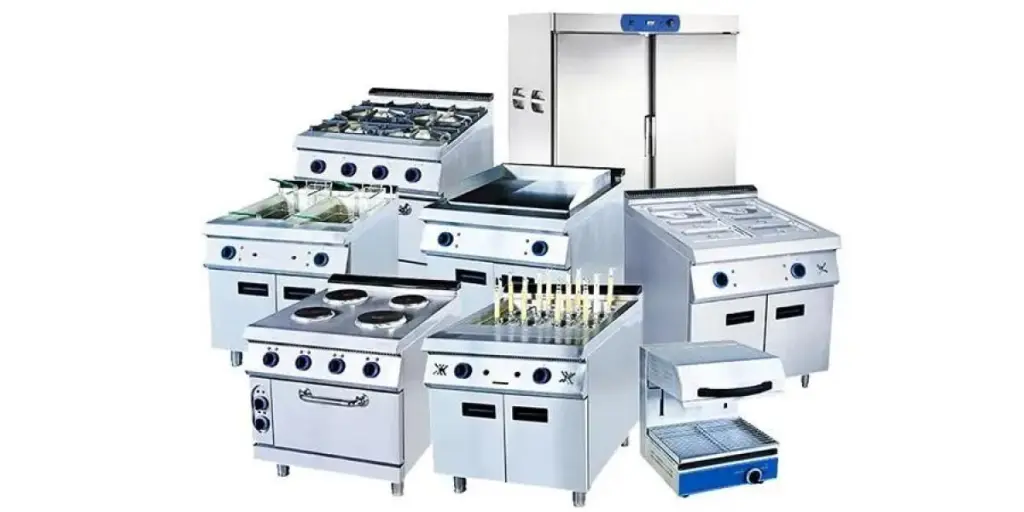Opening a new restaurant requires proper planning and organization, and this involves making sure that one’s restaurant kitchen is properly equipped to meet the business’s needs. Having the right kitchen equipment helps to prepare, bake, cook, wash, and execute the day-to-day culinary aspects of a restaurant.
However, with so many types of equipment available, and brands offering various models of each, one may be overwhelmed trying to establish which purchases are necessary for the restaurant’s success, and which are not. This guide provides a comprehensive list of the commercial kitchen equipment needed to succeed in the culinary business.
Table of Contents
Market growth for commercial kitchen equipment
Essential kitchen equipment for every restaurant
Factors to consider when purchasing kitchen equipment
Conclusion
Market growth for commercial kitchen equipment
In 2019, the global market size for commercial kitchen equipment was valued at US $79.72 billion and was projected to grow at a compound annual growth rate (CAGR) of 6.7% between 2020 and 2027.
Several factors propel this growth. Firstly, there has been a change in the youth population’s lifestyle. Many of the younger generation value a healthy diet, which contributes to the demand for healthy food chains, increasing the need for commercial kitchen equipment. Secondly, consumers are spending more on the hospitality and tourism sector, prompting restaurant owners to improve kitchen equipment to meet demand.
And finally, within the foodservice industry there is also a growing demand for smart kitchen equipment with advanced connectivity features, as well as increased demand for energy-efficient kitchen equipment, which will likely contribute to commercial kitchen appliance market growth.
Essential kitchen equipment for every restaurant
Furnishing a commercial kitchen with the right equipment can be expensive, which means it’s important to get it right. This guide outlines a list of essential commercial restaurant equipment to cover all the bases and ensure success.
Cooking equipment

The commercial kitchen relies heavily on cooking equipment. But before settling on any machine, one should ensure it will be used often. And although some restaurant owners invest in small and less expensive equipment, they may not always meet the restaurant’s needs, so it’s important to consider if the equipment has the capacity to match the kitchen’s requirements.
That said, below is a list of important cooking equipment for a commercial kitchen
Oven
There are different ovens used for baking, braising, and roasting. A restaurant owner may buy one or multiple ovens depending on the food they plan to serve, the available space, and the source of heat.
Cooking Range
One can choose a gas or electric cooking range depending on the kitchen setup. Alternatively, a combination of gas and electric range can prove useful if budget and the setup allow.
Deep fryer
Although deep fryers are synonymous with French fries and chicken tenders, this versatile item is also needed in a commercial kitchen for frying other foods like fish, meat, doughnuts, kale chips, onion rings, and so on.
Grill
Many customers love restaurants serving smoky or charred flavored meat. Having an operational BBQ grill in the kitchen will attract customers to the restaurant and improve its bottom line.
Toaster
A commercial kitchen can help with serving breakfast for early risers, hence the need for a commercial toaster for bread and bagels.
Coffee brewer
Coffee is a beverage loved by many people globally. Restaurant owners will greatly benefit from a coffee brewer since they will make this drink faster when demanded. Nevertheless, before settling for a coffee brewer, it’s important to ensure that it has the right capacity to meet demand.
Microwave
Using gas to heat sauces, reheat cold food, or defrost frozen products can take a long time and prove costly. However, heating may be sped up with a microwave, and costs can be significantly reduced.
Juice extractor
Many people are ditching soda for healthy juices. Therefore, a juice extractor is a must-have for any serious commercial kitchen to tap into this demand. This machine can make instant fresh juices to the customers’ delight.
Ice cream-making machine
Who doesn’t love ice cream? It is one of the most popular deserts enjoyed by young and old alike before and after meals. An ice cream-making machine will enable the restaurant owner to meet the growing demand for this delicacy and attract new customers.
Refrigeration equipment

Refrigeration equipment varies in style and size, and a restaurant’s choice will depend on the type of operations and refrigeration needs. Some factors to consider when choosing refrigeration equipment include capacity and size, and the unit should comfortably handle the intended items without spill-overs.
Refrigerator
A commercial kitchen cannot operate without a proper refrigeration facility. Besides keeping food fresh and delicious, having a fridge complies with regulations requiring the storage of raw ingredients at low temperatures to inhibit bacterial growth.
Common types of refrigerators one can choose from include pass-through options, walk-in coolers, prep fridges, and reach-in fridges.
Freezer
Freezers also come in different styles and sizes to suit the various needs of a restaurant. It is essential to consider energy efficiency and kitchen size before settling for a freezer. Some large commercial kitchens may need big freezers, while smaller freezers may suit less busy and smaller kitchens.
Ice machine
Most restaurants have beverage services, and ice is often needed to make these beverages enjoyable. Ice machines help to produce ice in large quantities to make blended cocktails and smoothies. Most restaurant owners consider the size of the machine, electrical setup, and commercial kitchen space when buying ice machines.
Storage equipment
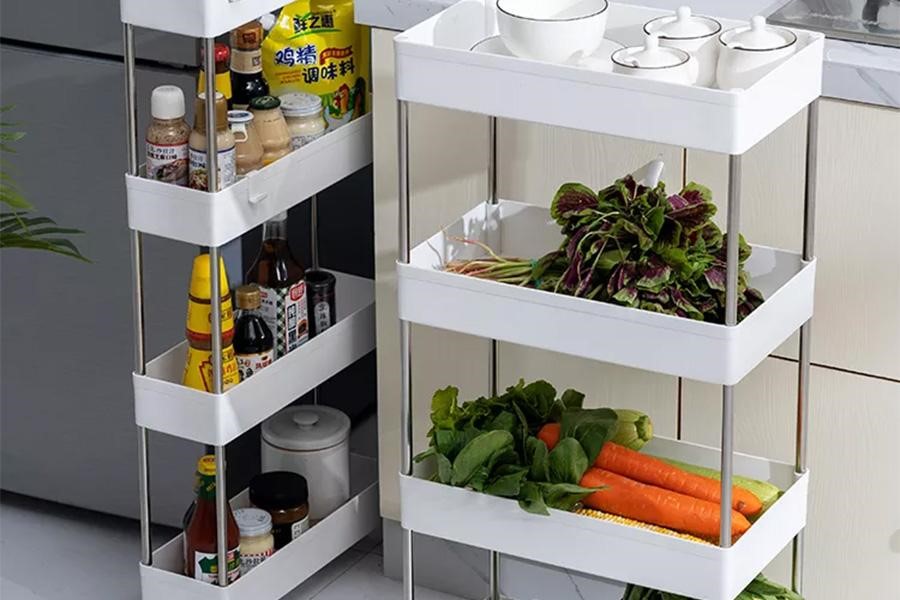
A restaurant will need storage equipment to keep ingredients and small wares used in the kitchen. Factors to consider when installing storage equipment include size, temperature, cost, location, accessibility, and convenience.
Some of the standard storage equipment includes:
Shelving
Shelves can be installed in the freezer or walk-in cooler for storing various foods. They can also keep pans, pots, dry ingredients, and dinnerware. The beauty of shelving is that it comes in different sizes, meaning it can be customized to suit any space.
Sheet pan racks
Although sheet pan racks can be used to proof bread, they are also designed to transport and store food items and utensils. Since they are often tall rather than wide, they are suitable for cramped commercial kitchens.
Cold room
Every commercial kitchen needs a well-ventilated place to keep food cold and prevent bacterial growth. Cold rooms are essential for refrigerating certain products that may not fit the refrigerator. They also make it easier to retrieve ingredients when needed.
Food storage containers
Food storage containers are versatile tools for storing prepped ingredients, stocks, sauces, or dry items. Additionally, they come with colored lids for easy marking and organization.
Dunnage racks
A restaurant needs dunnage racks for drying heavy equipment since they are lifted only a few inches from the ground. They often hold heavy items such as bags of rice, canned goods, flour, or large pieces of equipment.
Food prep equipment
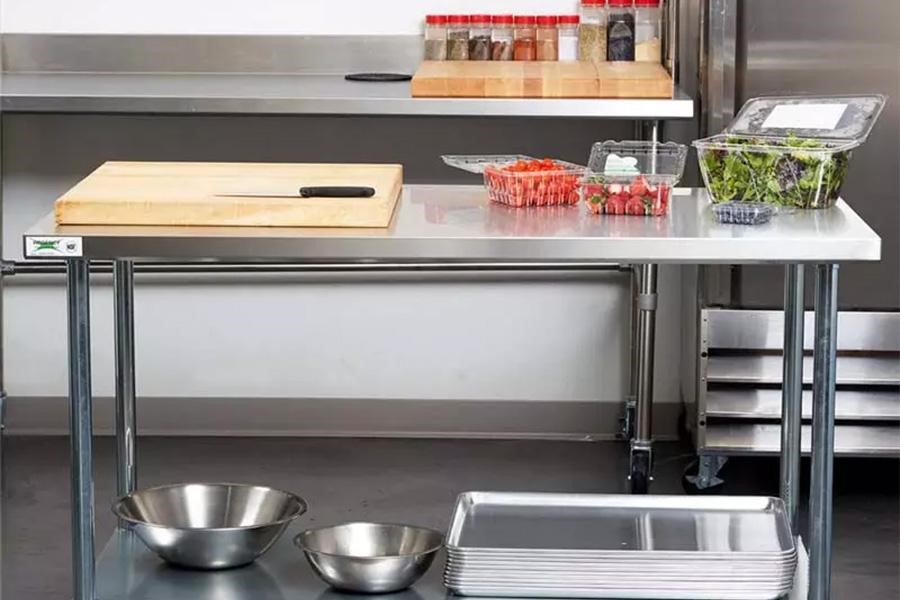
These equipment pieces vary from restaurant to restaurant, depending on the kind of cuisine to be served. The list below is limited to essentials that most commercial food kitchens may need:
Food processor
Food preparation can take lots of time, but with a food processor, prep time can be significantly reduced. Food processors can help to combine ingredients, make sauces, slice cheese, and chop vegetables. When choosing a food processor, examine its capacity, attachments, motor power, and design to see if it meets its intended purpose.
Mixers
Commercial dough mixers are predominantly found in pizza shops and bakeries to help mix baking ingredients. However, every restaurant can benefit from a mixer to facilitate mixing ingredients instead of mixing by hand.
Prep tables
Prep tables make work easier for any restaurant because they can hold equipment and appliances. Chefs can also prepare ingredients or assemble dishes on these tables with ease. Kitchen space will determine the type and size of prep table one buys for their commercial kitchen
Blenders
Blenders are one of the most versatile food prep equipment every restaurant needs. They can help make drinks, create marinades, combine sauces, or emulsify food.
Small ware equipment
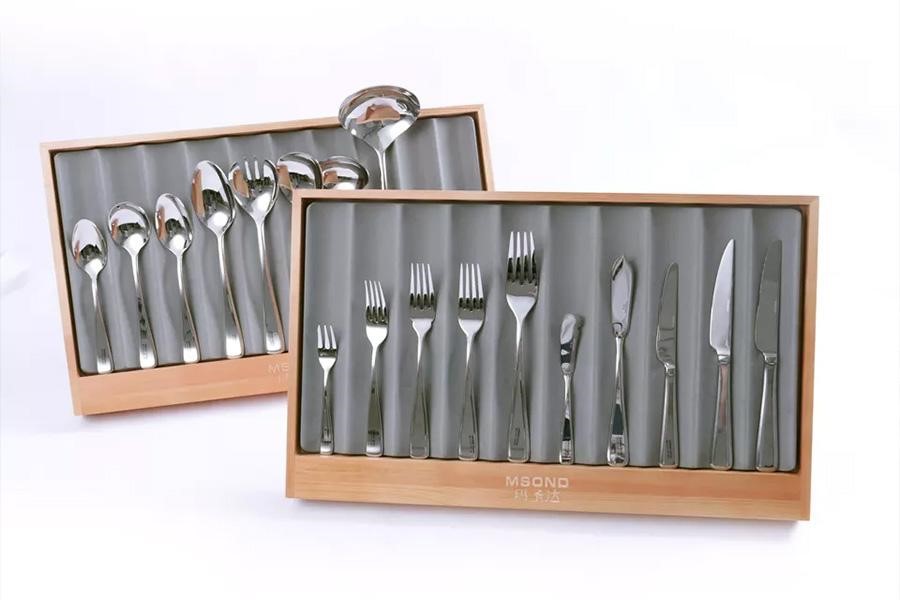
Small wares are equipment cooks use to prepare and cook dishes in the kitchen. They may not cost much for a new restaurant, but the restaurant owner should buy the right quantity and quality of items to ensure a well operated kitchen. When choosing small ware, consider their ease of cleaning, storage options, ease of use, and capacity.
The following are some essential small wares worth buying:
Chef knives
Every chef values a set of sharp knives since they make food preparation easier. Sharp knives also reduce the risk of cuts and accidents that are common in most kitchens.
Kitchen spoons
Of course, a functional commercial kitchen needs spoons to stir sauces, serve food at a buffet, or add ingredients to the pot.
Mixing bowls
Every commercial kitchen needs different sizes of mixing bowls to handle different ingredients.
Cutting boards
Cutting boards help with the fast preparation of ingredients and could also prevent cuts and accidents. Purchasing different cutting boards with multiple colors is advisable to avoid cross-contamination.
Pots
Pots are used for cooking various dishes, but the types a restaurant owner may choose will depend on the recipes they want to serve. They could choose stock pots, pasta cookers, double boilers, and sauce pots, amongst others.
Food pans
Dishes prepared in an oven need food pans to keep them warm until they are served to customers. They are valuable for a restaurant that hosts buffets or does outside catering.
Tongs
Tongs are useful for food preparation, serving, and plating, depending on the needs of each restaurant.
Janitorial equipment
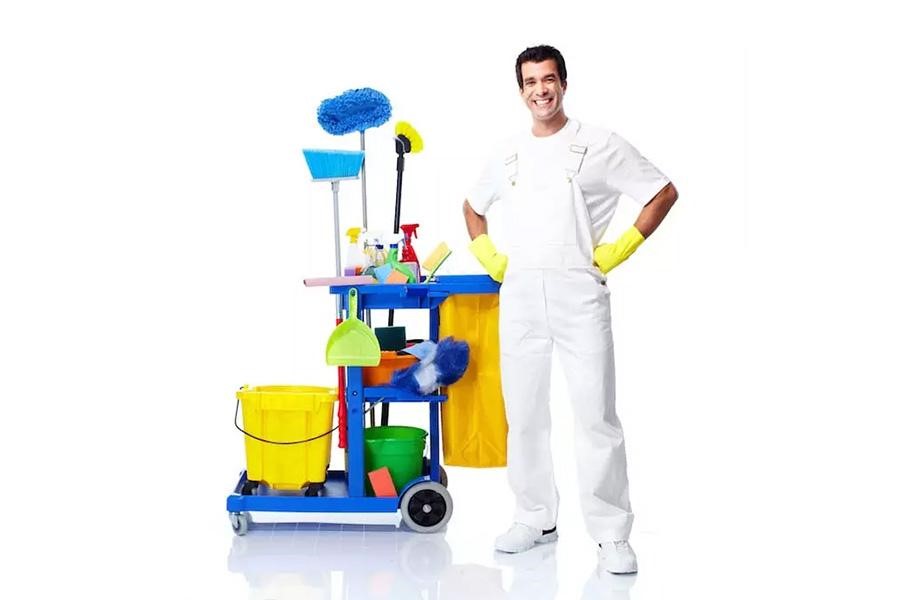
A clean restaurant attracts customers and needs to abide by government regulations. Therefore, new businesses should ensure they have the right janitorial equipment and supplies to improve the kitchen’s health and safety standards.
When stocking janitorial supplies, one would consider cleaning frequency, size of the area to be cleaned, efficiency in removing tough stains, and the restaurant’s hygiene standards. Consider this list of essential cleaning equipment and supplies for a restaurant:
Cleaning rags and microfiber cloths
Microfiber cloths and rags have many uses in a restaurant, from wiping tables and chairs to cleaning spills on the floor.
3 compartment sinks
Sinks are useful for cleaning dishes and products per health guidelines. Additionally, a restaurant owner can invest in commercial faucets and grease traps.
Mops and buckets
The floor of a busy restaurant needs regular cleaning throughout the day to keep the place habitable hence the need for mops and mop buckets.
Wet floor signs
Wet floor signs alert employees and customers to be cautious when walking on a wet floor.
Restroom supplies
It is expected that customers may want to use a restroom, and a clean restroom should have supplies such as hand soap, toilet paper, urinal cakes, paper towels, and baby changing tables.
Brooms and dustpans
Before mopping the floor, cleaners will probably want to sweep dust and drops of food particles off the floor. Brooms and dustpans are essential in sweeping and collecting the dirt.
Cleaning chemical buckets
Cleaning chemicals can be corrosive and need special buckets for mixing before they are used. These buckets come with different color codes to avoid contamination.
Factors to consider when purchasing kitchen equipment
Let’s examine some factors to remember when investing in a kitchen equipment:
Quality
One should always consider the state of the equipment, whether it is new or used. The equipment should be from a reputable manufacturer—and the materials used should be of high quality. If the equipment is not new but used, ensure it is in a good condition. One should also evaluate which restaurant equipment they often use and buy those with the highest quality.
Size and space
Commercial kitchen equipment has different dimensions, so it is important to determine how much space is available in the kitchen before buying it. The kitchen space and layout determine the dimension of every piece of equipment a restaurant owner will buy, and its important to ensure that the equipment purchased still allows free movement and doesn’t lead to overcrowding.
Ease of use and cleaning
Restaurant kitchen equipment should be easy for cooks to clean day in and day out. One can consider the equipment’s technical features to determine whether it is easy or difficult to operate and to clean.
Generally, stainless steel equipment is easy to clean, thus reducing the chance of bacteria contaminating food.
Pricing
Budget and pricing are important factors when purchasing restaurant equipment. Equipment that is used daily is worth a high price because it should be of high quality.
One can minimize the cost of equipment by buying multipurpose equipment to handle more than one job. For instance, investing in a combination oven that can cook by steam and convection instead of buying different ovens can save money, while buying used equipment in good condition can also be a money-saving alternative.
Ease of installation and maintenance
The equipment should be easy to install without requiring the services of a technician. And the frequency and cost of maintenance should ideally be minimal.
Capacity
Different commercial kitchen equipment has different holding capacities. For instance, fridges, ovens, pots, bowls, cold rooms, and preparation tables have varied capacities. If the amount of food being cooked is significant, a restaurant owner may need equipment with a larger capacity. However, if the meal quantity is small, equipment with smaller capacity will be ideal.
Applicable material
Various pieces of kitchen equipment are made using different materials. Equipment made from stainless steel is often durable and is suitable for daily usage. Although stainless steel equipment is relatively expensive, it is worth the price since it will last longer. Rarely used equipment, on the other hand, can be from wood, plastic, or other less expensive materials.
Conclusion
Commercial kitchen equipment can influence the running of the kitchen and the quality of food a restaurant serves its customers. This makes choosing the right kitchen equipment essential for a restaurant’s success. Besides looking for quality, size, capacity, and maintenance, a restaurant owner can consult chefs, designers, and technicians before settling for kitchen equipment. But this article has aimed to make this process easier, in order to help new business owners stock their kitchen with confidence.
